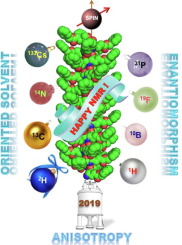当前位置:
X-MOL 学术
›
Prog. Nucl. Magn. Reson. Spectrosc.
›
论文详情
Our official English website, www.x-mol.net, welcomes your
feedback! (Note: you will need to create a separate account there.)
Multinuclear NMR in Polypeptide Liquid Crystals: Three Fertile Decades of Methodological Developments and Analytical Challenges
Progress in Nuclear Magnetic Resonance Spectroscopy ( IF 7.3 ) Pub Date : 2020-02-01 , DOI: 10.1016/j.pnmrs.2019.10.001 Philippe Lesot , Christie Aroulanda , Philippe Berdagué , Abdelkrim Meddour , Denis Merlet , Jonathan Farjon , Nicolas Giraud , Olivier Lafon
Progress in Nuclear Magnetic Resonance Spectroscopy ( IF 7.3 ) Pub Date : 2020-02-01 , DOI: 10.1016/j.pnmrs.2019.10.001 Philippe Lesot , Christie Aroulanda , Philippe Berdagué , Abdelkrim Meddour , Denis Merlet , Jonathan Farjon , Nicolas Giraud , Olivier Lafon

|
NMR spectroscopy of oriented samples makes accessible residual anisotropic intramolecular NMR interactions, such as chemical shift anisotropy (RCSA), dipolar coupling (RDC), and quadrupolar coupling (RQC), while preserving high spectral resolution. In addition, in a chiral aligned environment, enantiomers of chiral molecules or enantiopic elements of prochiral compounds adopt different average orientations on the NMR timescale, and hence produce distinct NMR spectra or signals. NMR spectroscopy in chiral aligned media is a powerful analytical tool, and notably provides unique information on (pro)chirality analysis, natural isotopic fractionation, stereochemistry, as well as molecular conformation and configuration. Significant progress has been made in this area over the three last decades, particularly using polypeptide-based chiral liquid crystals (CLCs) made of organic solutions of helically chiral polymers (as PBLG) in organic solvents. This review presents an overview of NMR in polymeric LCs. In particular, we describe the theoretical tools and the major NMR methods that have been developed and applied to study (pro)chiral molecules dissolved in such oriented solvents. We also discuss the representative applications illustrating the analytical potential of this original NMR tool. This overview article is dedicated to thirty years of original contributions to the development of NMR spectroscopy in polypeptide-based chiral liquid crystals.
中文翻译:

多肽液晶中的多核 NMR:方法学发展和分析挑战的三个肥沃十年
定向样品的 NMR 波谱可实现残留的各向异性分子内 NMR 相互作用,例如化学位移各向异性 (RCSA)、偶极耦合 (RDC) 和四极耦合 (RQC),同时保持高光谱分辨率。此外,在手性排列环境中,手性分子的对映异构体或前手性化合物的对映元素在 NMR 时间尺度上采用不同的平均取向,从而产生不同的 NMR 光谱或信号。手性排列介质中的 NMR 光谱是一种强大的分析工具,特别是提供有关(亲)手性分析、天然同位素分馏、立体化学以及分子构象和构型的独特信息。在过去的三年中,该领域取得了重大进展,特别是使用由螺旋手性聚合物(如 PBLG)在有机溶剂中的有机溶液制成的基于多肽的手性液晶(CLC)。本综述概述了聚合物 LC 中的 NMR。特别是,我们描述了已开发并应用于研究溶解在此类定向溶剂中的(前)手性分子的理论工具和主要 NMR 方法。我们还讨论了说明这种原始 NMR 工具分析潜力的代表性应用。这篇概述文章致力于 30 年来对基于多肽的手性液晶 NMR 光谱发展的原创贡献。我们描述了理论工具和主要的核磁共振方法,这些方法已经开发并应用于研究溶解在这种定向溶剂中的(前)手性分子。我们还讨论了说明这种原始 NMR 工具分析潜力的代表性应用。这篇概述文章致力于 30 年来对基于多肽的手性液晶 NMR 光谱发展的原创贡献。我们描述了理论工具和主要的核磁共振方法,这些方法已经开发并应用于研究溶解在这种定向溶剂中的(前)手性分子。我们还讨论了说明这种原始 NMR 工具分析潜力的代表性应用。这篇概述文章致力于 30 年来对基于多肽的手性液晶 NMR 光谱发展的原创贡献。
更新日期:2020-02-01
中文翻译:

多肽液晶中的多核 NMR:方法学发展和分析挑战的三个肥沃十年
定向样品的 NMR 波谱可实现残留的各向异性分子内 NMR 相互作用,例如化学位移各向异性 (RCSA)、偶极耦合 (RDC) 和四极耦合 (RQC),同时保持高光谱分辨率。此外,在手性排列环境中,手性分子的对映异构体或前手性化合物的对映元素在 NMR 时间尺度上采用不同的平均取向,从而产生不同的 NMR 光谱或信号。手性排列介质中的 NMR 光谱是一种强大的分析工具,特别是提供有关(亲)手性分析、天然同位素分馏、立体化学以及分子构象和构型的独特信息。在过去的三年中,该领域取得了重大进展,特别是使用由螺旋手性聚合物(如 PBLG)在有机溶剂中的有机溶液制成的基于多肽的手性液晶(CLC)。本综述概述了聚合物 LC 中的 NMR。特别是,我们描述了已开发并应用于研究溶解在此类定向溶剂中的(前)手性分子的理论工具和主要 NMR 方法。我们还讨论了说明这种原始 NMR 工具分析潜力的代表性应用。这篇概述文章致力于 30 年来对基于多肽的手性液晶 NMR 光谱发展的原创贡献。我们描述了理论工具和主要的核磁共振方法,这些方法已经开发并应用于研究溶解在这种定向溶剂中的(前)手性分子。我们还讨论了说明这种原始 NMR 工具分析潜力的代表性应用。这篇概述文章致力于 30 年来对基于多肽的手性液晶 NMR 光谱发展的原创贡献。我们描述了理论工具和主要的核磁共振方法,这些方法已经开发并应用于研究溶解在这种定向溶剂中的(前)手性分子。我们还讨论了说明这种原始 NMR 工具分析潜力的代表性应用。这篇概述文章致力于 30 年来对基于多肽的手性液晶 NMR 光谱发展的原创贡献。











































 京公网安备 11010802027423号
京公网安备 11010802027423号